
The following article contains excerpts and examples of paintings from an unpublished book authored by Darcy Lynn and a series of paintings she created that reflect her experience with the diagnosis and treatment of lymphoma. Ms Lynn feels that "by sharing [her] paintings with others [she] is able to communicate the impact of holding on to one's sense of self in times of crisis and that life is a gift that we should enjoy and value."
This is the story of my experience with lymphoma -- the adventures and thoughts I had during my illness, treatments, and recovery.
I fought my illness with the best weapon I had, my art. I've been painting almost all my life, after starting to draw at the age of two. I was born into art; my mother is an artist and so was her father. I don't believe l've ever wished to be anything other than an artist.
I painted to give definition and meaning to my illness. It was a way for me to translate all that I did not understand, and more importantly. it was a way for me to gain control over my illness. No one could tell me what or how to paint; it was up to me to express on the canvas how I felt.

I first noticed my shortness of breath while climbing the steep hills of Seattle. Believing it due to depression, I paid no notice. I'd just been laid off from a job I hated, although it provided me with the means to survive, and was bitterly disappointed with my life in this city.
I returned to New York in January 1991 and spent the next 3 months job searching and moving from place to place. I suffered bouts of flu and other discomforts but still believed it was all psychological. Meanwhile my shortness of breath grew worse. I went to see my physician, Dr Douglas, three or four times but never fully voiced my true ailments. My depression and ill health deepened, and I finally moved to my mother's tiny apartment in New Jersey; my money and health were almost depleted.
I made another visit to Dr Douglas, as my breathing had become more difficult. He took x-rays of my chest and immediately sent me to get CAT scans and to see a specialist; my lungs were filling with fluid. After looking at the scans, the specialist, Dr Loblolly, said, "Lymphoma or Hodgkin's disease--you do not have cancer. It wouldn't have mattered if you'd come in earlier; the treatment would've been the same." A large and intimidating man, his words did little to comfort me.
After waiting 5 days, I finally checked into the hospital. I could barely breathe lying down; the night before, many thoughts of death and cancer came into my head. How would I fight this illness? Where was the help I needed? I went through a series of painful tests, growing weaker and weaker by the minute. I waited in an examination room for the next doctor and test.
A quiet calm man walked in. He introduced himself as the oncologist, Dr Barnes, and said, "I am going to perform a bone marrow biopsy to make sure the lymphoma has not spread to your bone marrow." His intelligent face and composed manner soothed me--here was someone who knew what he was doing. He performed the biopsy, which hurt, but as I felt no fear, it was bearable. He then had me see another doctor.
A tall man wearing a mustache and a grin came in, "Hello, I am Dr Leonard and I've come to help you feel better. I'm going to drain some of the fluid off the area around your heart to ease the pressure on it." lie helped me onto a stretcher to take me to presurgery.
"I heard you are an artist. When this is over, will you paint a picture lot me?"
"Yes, I would love to," I replied weakly. I was pleased that somebody told him I was an artist--my identity.
In presurgery he set me up on a bed, numbed my chest with local anesthetic, and began to drain the fluid. A crowd of nurses and interns gathered to watch. I averted my eyes from them and looked at Dr Leonard. For a young man he sure had a lot of grey hair. "You are such a good patient!" he exclaimed. Fearing I might distract him I watched his hands and the tubes filling up with red-brown muck. After the fourth tube filled, he stopped. "There, that should help you some." He smiled and dressed the wound.
The next day Dr Douglas walked in, smiled, and sat on my bed. I felt reassured by his presence. He had been my physician for 15 years and always made me feel safe.
"Darcy, Dr Leonard will have to perform a biopsy, just a small incision under your collar bone. We still don't know what type of lymphoma you have."
It wasn't until 6 pm that I was finally wheeled into the operating room. The anesthetic was administered and I became groggy. They attached things to me that I could not distinguish. I heard Dr Leonard speak over my head.
"Okay Darcy, we will be done real soon." I looked up and saw only his eyes. I went under.
I awoke in intensive care to see the anesthetist and Dr Leonard peering into my face, their heads quite close to mine.
The anesthetist smiled at me. "You're awake and we have you back. I spent most of the night here with you." She gestured to some blankets on the window sill. I turned to look at them and then blacked out. I awoke later and began to take in my situation. I was on a respirator --that explained the tubes in my nose and throat, and the beeping noise. But there were other things in me as well. Three IVs, a chest tube, a catheter in my bladder, a blood pressure strap around my arm, and a little box tied to a ribbon around my neck with three small suction cups placed near my heart.
Finally, I felt a strange numbness under my left breast; it was the incision Dr Leonard had made for the biopsy. Why it was there instead of below my collar bone, I did not know. (I found out later that he had performed life- saving surgery, as l had nearly drowned in the lymphoma muck.)
I received the first of my chemotherapy but was very groggy and unaware at the time. (I found out later that this, too, was lifesaving: the chemotherapy shrank my tumor by 70%.)
 I wanted to see if I could still draw. (Gripping a little pencil and graph pad
I got from the intern, I drew a potted plant that was on the counter of the
nurse's station. It reminded me of a Matisse painting, sitting precariously
near the edge. Yes, I still had the ability.
I wanted to see if I could still draw. (Gripping a little pencil and graph pad
I got from the intern, I drew a potted plant that was on the counter of the
nurse's station. It reminded me of a Matisse painting, sitting precariously
near the edge. Yes, I still had the ability.
After 3 days in intensive care, I was moved to a double room in the hospital. I was given the second half of my first chemotherapy treatment; I was to have a total of six, all in two parts. Except for slight nausea and vomiting, I felt pretty good and began to draw in a sketchbook that my sister, Amy, had brought me. She also had brought some photos of my paintings to show Dr Douglas and Dr Leonard.
Both doctors loved my work and were amazed that I was really talented. I was very pleased. I told them that I wished to paint their portraits, including Dr Barnes'. They were eager and agreed. Dr Leonard said, "We will be the Three Musketeers!" and he gestured with an imaginary sword, "One for all and all for one!"

The next few weeks were a period of recuperation and learning. I was regaining my strength, finding out what damage had been done to my body, and learning about the many medications I needed to take in conjunction with the chemotherapy.
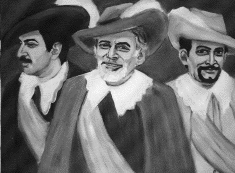 The Three Musketeers, Oil on canvas, 24 x 18
The Three Musketeers, Oil on canvas, 24 x 18
My skin had become sensitive from the chemotherapy, so I was too nervous to shave my head. Instead I cut my hair. The saying "If it offends you, cut it off" came to mind as I clipped away. I did not stop until all I had was "peach fuzz," about a quarter inch of hair. In some places I had bald patches.
My first reaction to the new look was to notice that my eyes had grown twice their size and my head appeared totally defenseless. I ran my hands along my scalp, and my skull feat reassuring. I turned my head left and right, trying to adjust to myself. All I saw was vulnerability, no place to hide, and now everything showed on my face more than ever!
That was the head. Now I had to deal with the body -- my incision first. A deep rose-colored scar running along the curve under my left breast caused numbness in my left side from my ribs up to my breast as far as the nipple. This was because all the nerves had been cut during surgery. I also had two smaller scars on my chest, one where all the fluid by my heart had been drained and another where my chest tube had been. Both held scabs that fell off early, leaving more rose-colored marks. I looked down at my chest; the scars were reminders of my battle with death. I reflected on them sadly but with pride.
I had two projects to work on, eating and taking medications. I lost the art of eating in the hospital, but it miraculously returned when I got out!
I went to see Dr Douglas for a check-up and showed him my bald head. His response boosted my ego: "You look like a fashion designer!"
My mother and I moved into an apartment in Brooklyn to be closer to the hospital. I set up my easel and paints and got to work. I was very excited and happy, but I started to feel hot. The next day my temperature bit 101 degrees F. I rang Dr Barnes, who instructed me to come to the hospital and to pack a small bag in case I had to stay in the clinic. He told me I probably had an infection.

My stay in the clinic was one of routine: a schedule of IV antibiotics, meals, tests, and doctor visits. The only reassuring presence was my nurse, Helen. She listened to my complaints and fears, both physical and emotional in nature; she always seemed to have time for me.
During my earlier stay in the hospital, Dr Barnes mentioned that I'd need a Hickman catheter at some point. When he saw my arms, he decided it had better be done soon. He also informed me that my stay would be a total of 3 weeks, as my infection was an unidentified one, requiring 21 days of antibiotics.
The operation for the catheter, performed by Dr Leonard, went very well. But the day after the operation, reality set in. A 16-inch tube was sticking out of my chest that required special care and attention. What had I accepted?

I was released from the clinic in mid-June and was now halfway through my chemotherapy. I had lots of time to paint, but only after I had figured out how to structure my life around chemotherapy, 12 days on prednisone, and care of my Hickman.
When I finally mastered, "Proper Care and Maintenance of the Hickman," I found out it would be there for many months. The best way for me to handle it was with humor. I wrote a comic poem about the catheter, which went like this:
|
by Darcy Dovetonsils' All the clicking and clacking as you dangle between my boobs. I detest you most while I am in the shower. I wish you'd get out of me, our relationship has gone sour! Pretty bad, I admit, but Hickman wearers will appreciate it!
|
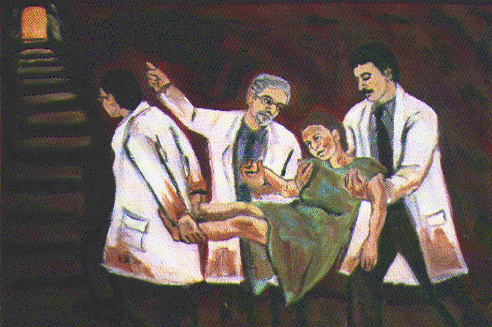
Pietal/Start of the Climb was the first of the series. The idea for it came to me while I was in intensive care; I later did a sketch of it while in the clinic. The scene depicts my doctors rescuing me from a sewer of lymphoma, carrying me to the light at the end of the tunnel. Each is placed symbolically to show his role in my survival. Dr Barnes pulls me by the ankles to the exit --he has a cure. Dr Leonard supports me under the arm, protectively, while Dr Douglas holds my hand and points to the exit, encouraging me to keep on fighting and to believe in myself. We are all covered in lymphoma muck, because they came right down into the sewer with me.

Self-Portrait With Hickman and Scar, Oil on canvas, 16 x 24
This painting was a turning point for me. It was the first time I have ever painted myself nude. I photographed myself using a timer and worked from that image.
My dear friend Julia (who gave me the idea for the series) said, "Paint everything." Part of that was to lace my scars and know that I am still alive.
 |  |
| After the tubes in my mouth and nose were removed in the intensive care unit, I was given oxygen. This is the image I saw, myself and two large protective seals swimming underwater. We did not surface, swimming straight in our heaven underwater. My chest tube added to the effect, as it made sounds like bubbles underwater. | Nurse Helen is also a tribute, to her and to all the nurses who gave so much of themselves. While in the hospital, I found that it was often a nurse who comforted me when I felt scared or alone. My appreciation of and respect for nurses grew enormously. |
Due to the small space in my room, the only way I could paint on a large scale was to use separate canvases. To prepare for Doctor Triptych, I photographed my doctors without their white lab coats, being careful to get their hands within the picture frame.
 |
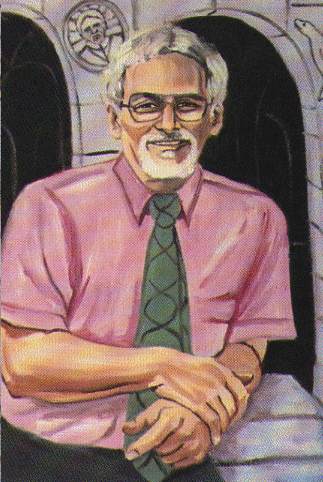 |
 |
| Dr Barnes | Dr. Douglas | Dr. Leonard |
I painted them in bright colors against a dark, medieval-looking background to contrast the fear of the unknown with the very real and reassuring presence of my doctors. In the pillars I placed symbolic images of each doctor based on my sketches from the hospital. Dr Barnes is The Preacher, Dr Douglas is Sunshine, and Dr Leonard is The Knight with his sword. In each one, I also placed a seal, my symbol of hope. The painting is my tribute to them for the physical and emotional care they gave me.

September came, and I finished chemotherapy. I had run out of ideas for my series, so I returned to painting nature.

This painting is based on my reflection in the lights of the operating room after the Hickman catheter was put in. It shows my vulnerability and dignity. I found that by admitting my vulnerability, I could accept and live with it.
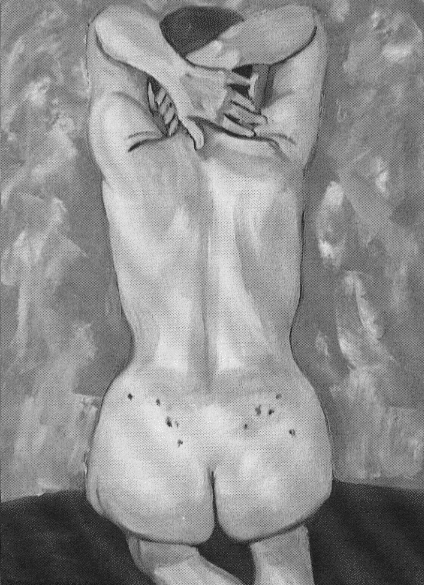
I had a check-up with Dr Barnes in mid-September. He told me I was doing very well and that the next step was radiation. But prior to that I needed a bone marrow harvest in case the lymphoma returned and I required a transplant.
I had an appointment with Dr Blake, the radiotherapist, so she could set me up after the harvest. She was an alert, spunky woman, and we took to each other immediately.
After my harvest (which was scary for me because I had to go to another hospital) I limped into my hospital for radiation therapy. I was full of holes and had to count them all, like the Beatles song, A Day in the Life. My chest was then painted with fuchsia T's and L's for the first eight "zaps" of the treatment. I would receive a total of 24 in the end, the last 16 being around my sternum.
The day I received my blue tattoos I ran a low-grade fever so I was sent for x-rays and cultures. I went to see Dr Barnes, who informed me the x-rays showed nothing. "I think we will wait to see if your cultures show anything before I decide to put you on antibiotics."
"IV antibiotics?" I asked warily, fearful that I would be put back into the clinic.
"No, it would be oral antibiotics."
"Good." No clinic, I thought to myself. "You mean we can't go to Washington Square Park?"
"Sure we can go to Washington Square Park," he said as he listened to me and my heart at the same time. "Why are we going there?" He gave me a quizzical look.
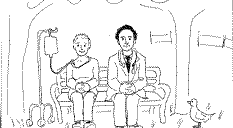 Dr Barnes and me, looking for "drugs" in Washington Square Park
Dr Barnes and me, looking for "drugs" in Washington Square Park
"To get drugs."
"Oh right, I got you. No, we don't need to go there." By now, Dr Barnes was used to my jokes.

I finished all my treatments on November 22 and had my Hickman removed mid-January, the new year. For reasons unknown to me I fell into a deep depression. I tried to rationalize it, telling myself I was missing all the attention from my doctors and people around me, but I could not seem to rid myself of a growing darkness in my soul.
I went to see Dr Douglas and asked him about my depression. He told me it was natural for people to go through a depression after recovering from a serious illness.
"But why?" I asked him. "It's all over and I'm free."
"After spending so much time fighting your illness and handling the treatment, it all ends and you feel abandoned."
"Yes, I figured that part. But this inner darkness?" I braced myself for my next question. "Did I almost die?"
"Well, let's just say you came real close to biting the dust."
"Oh." I felt relieved that I was now admitting it aloud.
"I keep thinking about it--the fact I almost died. It is all finally registering."
"You were lucky and survived. Look at it this way. were in the sick world, and now you are in the well world." But I sti11 felt unsure about how to handle my sion. Dr Douglas suggested I paint it out, which I did.
I painted, pastelled, and drew, asking myself what was like and how I felt now. I drew black charcoal pictures of myself in a world of darkness. I had to reflect that night in the operating room, on my determination to live and to see who I had become.
In the end I realized it would always be with me: I had fought death and could not pretend nothing had happened. I just needed to incorporate the experience into my life, which was now exciting and enjoyable to me. My art and I continue to flourish.